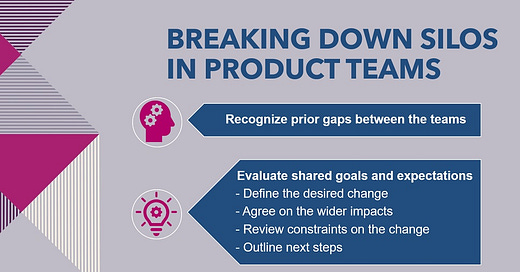Your product is getting interest from customers and sales. At last, you're getting a trickle of new customers. However, there are many surprises with the new customers! The new customers need much more support for onboarding than anyone expected. And you still have major product gaps that the early customers want to be fixed. As a result, your delivery team is unable to keep up with closing product gaps. Your costs are going up faster than revenue.
Example of Silos in Your Team
You investigate the issues with delivery and you find one delivery team is consumed with customer support and another delivery team is not busy at all. Next, you learn the two key delivery teams are not working together to support customers. These two teams have had a poor experience working together in the past. You need to get these teams working together to continue product growth and reduce costs.
How can you get key teams to work together toward supporting your customers? Escalation to your stakeholders will not work since costs are going up faster than revenue. You need to spend time with customers instead of brokering a better working relationship between these teams. What other options are there to break down these silos?
Steps in Breaking Down Silos
It is challenging to bring teams together after a prior poor experience, but it can be done. The steps to take are:
Acknowledge the prior issues from working together
Review shared goals and reset expectations
Encourage ongoing collaboration
Let's discuss how to break down these silos and get these teams working together.
Step 1: Acknowledge the Prior Issues
Recognizing the cause of the teamwork issues is the first step. There are likely real problems in the past that have led to the disconnect between the teams. It is key to hear the concerns of each team. Typical issues that cause teams to fall apart are:
Mismatch in knowledge: one team knows the technology better than the other
Prior history: one team has stronger relationships with key stakeholders
Size of team: one team is bigger than the other team
Mismatched priorities: one team's priorities are in conflict with another team
At this point, you hear both teams out and agree there were issues in the past. Neither team is right or wrong! The crucial result is acknowledging there was a problem in the past before moving to the next step.
Step 2: Review Shared Goals and Reset Expectations
This step is best handled in a meeting and not over email. With a little preparation, you can lead these teams to a shared understanding of the reasons to work together and common expectations. The steps to facilitate this meeting are:
Define the desired change: what is the desired outcome of the shared goals?
Wider impacts of the change: what is the impact of the change from the perspective of stakeholders?
Constraints on the change: what is holding the teams back from changing?
Next steps: what are the roles and responsibilities in making the change?
An example of doing this when there are two disconnected teams:
Desired change: grow product faster than costs
Wider impact of the change: product margin improvement and additional customers
Constraints on the change: more training and working together on changes
Next steps: training plan and plan to work together on a new requirement
The outcome of these steps is an updated set of shared goals and expectations of the teams working together. The final step is to find ways to keep the collaboration going.
Step 3: Inspire More Collaboration
The silos between the teams are almost broken after the shared goals meeting. You can push the teams to bridge their remaining gaps by:
Reporting on the shared goals to your stakeholders
Reviewing the agreed benefits of working together
Periodic updates to the product team on progress toward the goals
By focusing on the higher-level benefits of shared goals, cross-functional relationships are built and the silos are broken down.
Conclusion
Effective collaboration between teams leads to cost reductions and product scale. Cross-functional teams can grow apart by mismatched priorities, investment decisions, and knowledge gaps. Product leaders that rely on cross-functional teams working together frequently encounter silo-ed teams that aren't collaborating. Taking these three steps can create a productive relationship between teams:
Recognize prior gaps between the teams
Agree to shared goals and expectations
Foster ongoing collaboration
There are many complexities between teams that can hinder collaboration. Working through these steps enables teams to stay productive together.
If you are interested in some systems thinking for working through teamwork issues, here are a few helpful links:
Soft Systems Methodology Organized way of thinking through a problem situation.
Dialog Mapping An approach to clarifying a complex, ill-defined problem that involves multiple stakeholders. Includes a cool way to diagram a facilitated discussion.





Experiencing some of these opportunities in my own world. Great thought stimulators around some things I should try with our team.